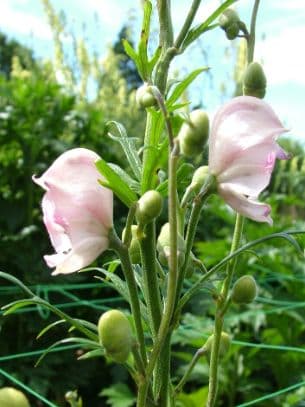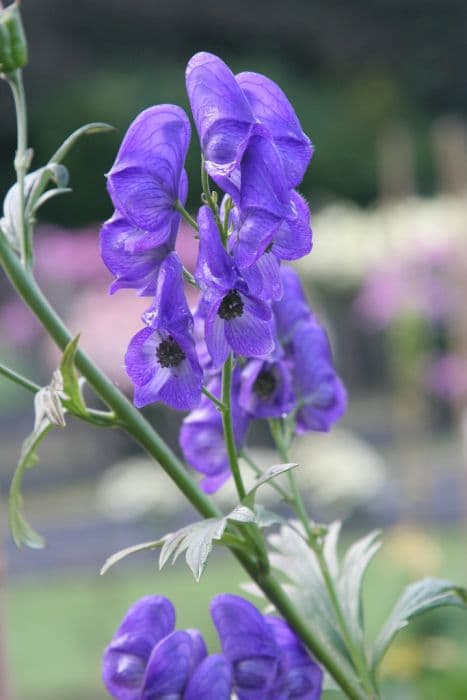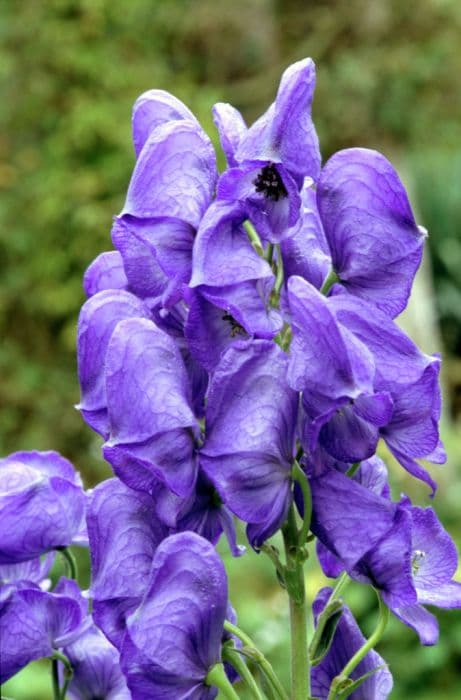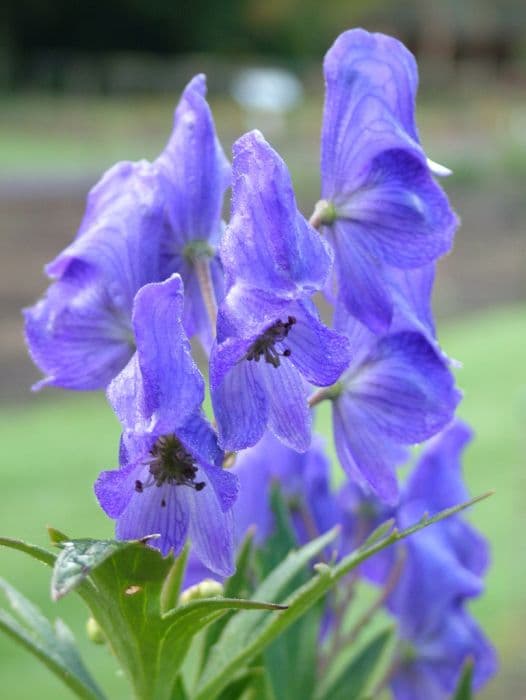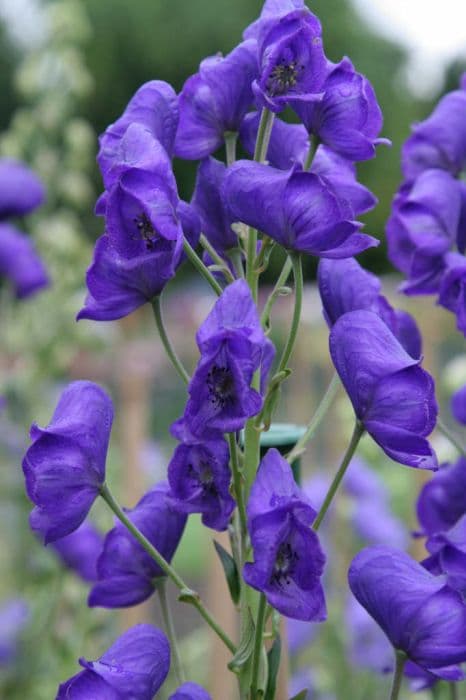Larkspur Delphinium 'Purple Velvet'

ABOUT
Delphinium 'Purple Velvet' is renowned for its striking, vibrant purple flowers that bloom on tall spikes. The blooms comprise of numerous small, tightly packed individual flowers arranged in a dense columnar cluster. These flowers exhibit a rich, velvety purple hue that tends to draw the eye, making them a standout feature in any garden setting. Each flower is beautifully shaped with five petal-like sepals that spread outwards, often displaying a lighter or sometimes white bee, or central area, which helps to accentuate the floral display. The foliage of Delphinium 'Purple Velvet' is also quite appealing, comprised of deeply lobed, green leaves that form a bushy clump at the base of the stems. The texture of the leaves offers a nice contrast to the softness of the blooms, providing a lush backdrop that further highlights the flowers. With its bold color and regal presence, this plant is often used as a backdrop in garden borders, and its flowers frequently grace cut-flower arrangements where their dramatic look offers an eye-catching appeal.
About this plant
 Names
NamesFamily
Ranunculaceae
Synonyms
Larkspur, Delphinium
Common names
Delphinium 'Purple Velvet'
 Toxicity
ToxicityTo humans
Larkspur, including the 'Purple Velvet' variety, is highly toxic to humans if any part of the plant is ingested. The plant contains various alkaloids, such as delphinine, which can pose serious health risks. Symptoms of larkspur poisoning can include nausea, vomiting, abdominal pain, muscle weakness, paralysis of the respiratory system, and convulsions. In severe cases, ingesting larkspur can lead to respiratory failure and death.
To pets
Larkspur is also highly toxic to pets, including cats and dogs. Like in humans, all parts of the plant contain dangerous alkaloids. Symptoms of larkspur poisoning in pets can exhibit as drooling, nausea, vomiting, diarrhea, muscle tremors, stiffness, weakness, seizures, paralysis, and potential heart failure. Eating larkspur can be fatal to pets, so it is crucial to seek veterinary care immediately if ingestion is suspected.
 Characteristics
CharacteristicsLife cycle
Perennials
Foliage type
Deciduous
Color of leaves
Green
Flower color
Purple
Height
4-6 feet (1.2-1.8 meters)
Spread
1-2 feet (0.3-0.6 meters)
Plant type
Herb
Hardiness zones
3-7
Native area
Northern Hemisphere
Benefits
 General Benefits
General Benefits- Ornamental Appeal: The Delphinium 'Purple Velvet', commonly known as Larkspur, has tall spikes of vivid purple flowers that add dramatic color to gardens.
- Attracts Pollinators: It is known to attract bees, butterflies, and other beneficial pollinators which are essential for the pollination of many plants.
- Vertical Interest: Larkspur plants can grow quite tall, providing vertical interest that can break up the monotony of lower-growing plants in a garden bed.
- Seasonal Color: They typically bloom in the early summer and can add seasonal color to gardens when many other plants are not yet in bloom.
- Cut Flower Use: Larkspur flowers are long-lasting when cut and are popular in floral arrangements and bouquets.
- Wildlife Habitat: Their structure provides shelter and nesting spots for small wildlife within a garden ecosystem.
- Companion Planting: Larkspur can be used in companion planting to help protect vegetables from pests due to their height and the fact that they attract beneficial insects.
 Medical Properties
Medical PropertiesThis plant is not used for medical purposes.
 Air-purifying Qualities
Air-purifying QualitiesThis plant is not specifically known for air purifying qualities.
 Other Uses
Other Uses- Delphinium fibers can be used in textile applications, where the stems of the plant are processed to create a natural fiber for weaving or knitting.
- Ink production from Delphinium petals may provide a natural dye source for art supplies, potentially offering a range of purple hues.
- Delphinium can be incorporated into eco-friendly confetti, with dried petals serving as a biodegradable alternative to traditional paper or plastic confetti.
- The dried stalks of Delphinium can be used in crafting, such as in the creation of rustic wreaths or as support stakes in small garden arrangements.
- The plant can be used as a natural pH indicator in educational settings, with the pigment in the petals changing color based on the acidity or alkalinity of the solution.
- Delphinium, as a source of vibrant color, can be used in the craft of candle making, tinting the wax naturally without synthetic dyes.
- During thematic events or historical reenactments, Delphinium blossoms can serve as an authentic decoration to replicate gardens from specific historical periods.
- In photography, Delphinium can be used to create a natural backdrop or as an aesthetic element in still life compositions.
- Delphinium flowers can be pressed and used in the craft of making handmade paper, providing texture and color to the finished product.
- As an educational tool in botany classes, Delphinium can be used to help students learn about plant structure, growth, and reproduction through hands-on cultivation and observation.
Interesting Facts
 Feng Shui
Feng ShuiThe plant Delphinium is not used in Feng Shui practice.
 Zodiac Sign Compitability
Zodiac Sign CompitabilityThe plant Delphinium is not used in astrology practice.
 Plant Symbolism
Plant Symbolism- Protection: Delphiniums are often associated with protection, particularly in European folklore where they were used to ward off evil spirits and negative energies.
- Openness to New Experiences: The light and airy feel of delphinium blooms symbolize an openness to new experiences and opportunities.
- Arrogance and Boldness: In the Victorian language of flowers, delphiniums signified a big-hearted person, but it could also indicate someone who is holding onto some arrogance.
- Heavenly Ascent: The tall, spire-like blooms of the delphinium can suggest an upward journey to the heavens, symbolizing ascension and spiritual growth.
- Goodwill and Encouragement: Flower givers often choose delphiniums to convey a message of goodwill, encouragement, and cheer to the receiver.
 Water
WaterLarkspur, commonly referred to as Delphinium 'Purple Velvet', should be watered deeply to encourage root growth, amounting to about 1 inch of water per week. The soil should be kept moist, but not waterlogged, reducing watering frequency during cool or rainy periods. During the growing season, especially in dry and hot weather, it may be necessary to water two to three times a week to maintain consistent soil moisture. Ensure to water at the base of the plant to avoid wetting the foliage, which can lead to disease. Each watering session should thoroughly soak the soil to a depth of at least 6 inches.
 Light
LightLarkspur thrives in conditions where it receives full sun for at least 6 to 8 hours a day. It is essential to place it in a location that gets plenty of direct sunlight, as this will ensure optimal growth and flowering. However, in extremely hot climates, some light afternoon shade can be beneficial to protect the plant from intense heat.
 Temperature
TemperatureLarkspur prefers moderate temperatures and can generally tolerate minimum temperatures down to 40 degrees Fahrenheit, while maximum temperatures should not exceed 85 degrees for extended periods. The ideal growing temperature range for Larkspur is between 50 and 75 degrees Fahrenheit, which encourages vigorous growth and flowering.
 Pruning
PruningFor Larkspur, pruning is necessary to promote bushier growth and to remove spent flower stalks, which encourages further blooming. Deadheading, or the removal of faded flowers, should be done regularly throughout the blooming season. After the first flush of flowers has faded, cut back the flower stalks by one-third to one-half to stimulate a second wave of blooms. The best time for more significant pruning is in late winter or early spring before new growth begins.
 Cleaning
CleaningAs needed
 Soil
SoilLarkspur 'Purple Velvet' thrives in a soil mix with good drainage, rich in organic matter. The best soil mix can be achieved by blending one part loamy soil, one part peat or compost, and one part perlite or sand. The ideal pH level for Larkspur is between 6.0 to 7.5 to support its growth and flowering potential.
 Repotting
RepottingLarkspurs, including 'Purple Velvet', typically do not require frequent repotting and can be repotted every 2-3 years. Due to their deep root systems, choose a deep container and ensure proper drainage at the bottom.
 Humidity & Misting
Humidity & MistingLarkspur 'Purple Velvet' is relatively tolerant to a range of humidity levels but prefers a moderate humidity environment. It performs well in outdoor ambient humidity, avoiding the extremes of too dry or excessively humid conditions.
 Suitable locations
Suitable locationsIndoor
Ensure bright light and cool temps for indoor Larkspur 'Purple Velvet'.
Outdoor
Plant in sun, provide support, and protect from strong winds outside.
Hardiness zone
3-7 USDA
 Life cycle
Life cycleThe Larkspur 'Purple Velvet' begins its life cycle when seeds are sown in late winter to early spring after a period of cold stratification to break seed dormancy. Germination occurs within a few weeks, and seedlings emerge to establish a rosette of basal leaves. Throughout the spring and early summer, the plants develop a tall flowering stalk with deeply lobed leaves, and in midsummer, they produce tall spikes of velvety purple flowers attractive to pollinators. After flowering, typically from late summer to fall, seeds develop and are dispersed near the parent plant. Should conditions permit, such as a temperate climate with proper care, Larkspur 'Purple Velvet' may undergo a period of dormancy before returning the following spring. If the plant is treated as an annual, it completes its life cycle within one growing season, dying after seed set, but if treated as a perennial in suitable zones, it will grow back from the rootstock in subsequent years.
 Propogation
PropogationPropogation time
Early Spring
The Delphinium 'Purple Velvet', commonly known as Larkspur, is most commonly propagated by seed. The best time to sow Delphinium seeds is in the spring after the danger of frost has passed, or they can be started indoors about 6 to 8 weeks before the last expected frost date. Sowing seeds directly into the garden is possible, but starting them indoors can give them a headstart. The seeds should be sown on the surface of a well-draining soil mix, as they require light to germinate. After sowing, the soil should be kept moist but not waterlogged. Germination usually occurs within 2 to 3 weeks when kept at temperatures around 65 to 75 degrees Fahrenheit (18 to 24 degrees Celsius). Once the seedlings have developed a couple of sets of true leaves, they can be hardened off and transplanted into the garden spaced about 12 to 18 inches (approximately 30 to 45 centimeters) apart.

